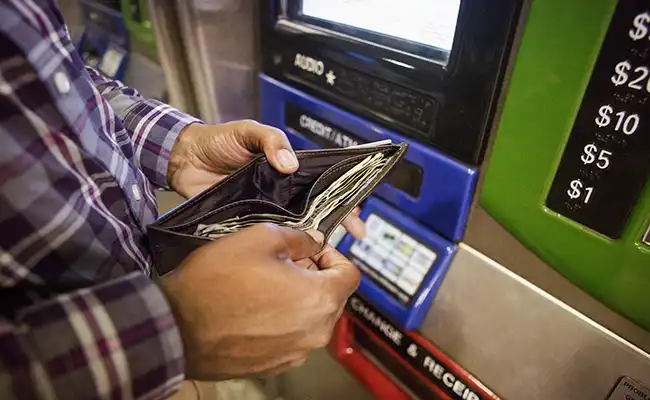For transit agencies and riders alike, digital payments are the new normal.
Over the last decade, we’ve seen agencies around the world embrace account-based payment processing (ABP). As real time processing, wireless broad brand, and cloud computing have all matured the old “account on card” models are progressively falling away.
For riders, ABP has meant a variety of new payment options both in terms of media and funding options. Contactless smart cards, wrist bands, fobs, mobile phones, contactless bankcards, smart ID’s, and barcode credentials can all be used as entry tokens each offering new flexibility in the crafting of commercial partnerships, fare policy, and user convenience.
For many agencies, the ability to accept bank issued contactless media (whether via card or mobile wallet) means reduced costs surrounding card issuance and cash handling, as well as significant gains in simplifying the user experience for visitors and infrequent riders looking to access transit. So too does it create potential for new branding and marketing partnerships targeted at the core ridership community.
While such opportunities are truly exciting, in a variety of the transit markets ridership demographics often fail to dovetail with those where contactless bankcard products are well adopted. Even where there is a strong demographic fit, there exist user segments such as youth, students, and the elderly where such products are not well positioned to support discounts and specialty access programs.

According to data from the FDIC, 4.6% of households in the United States — representing roughly 5.6 million households — are unbanked, meaning that no one in the household has an active checking or savings account. More than 14% were considered underbanked, meaning they rely on non-bank products to meet their core financial needs. For these riders, cash is a necessity, and many of the conveniences offered by digital payments remain seemingly out of reach.
The power and flexibility of ABP in tandem with digital payments deliver a broad range of benefits to transit agencies. Properly positioned, agencies can enjoy those benefits while not only ensuring equitable access, but equitable benefit from the new system.
Beyond Rider Convenience: Benefits of Account-based Payments Processing
The shift towards digital payments and ABP hasn’t just been convenient for passengers; it also offers valuable benefits for the agencies themselves.

-
Boarding Times:
Passengers preloading accounts or paying with bank cards and mobile wallets can move through gates and tap onto buses more quickly than those fumbling with cash. That means faster boarding times on buses and less congestion in stations. This results in less delays and creates a more pleasant experience for everyone involved. -
Operational Costs:
Operational costs are lowered by reduced cash handling and card issuance. The various account funding options allow agencies to influence and manage their payment mix via fare policy as well. Bus drivers are also safer because they’re carrying less cash onboard their vehicles. -
Flexibility:
ABP enables agencies greater flexibility in their fare products, including fare capping, travel rewards, transfer discounts and best fare guarantees. It also makes it easier to make changes and add new modes or services as changes occur. -
Partnerships and Modal Extensions:
ABP significantly eases collaboration with multi-modal partners and extension of account acceptance via various forms of secure credentials. University ID’s, mobile drivers’ licenses, QR codes, and third-party mobile apps, all provide opportunities for creative program development. -
Data:
Digital payments provide agencies with a wealth of data which can be used to optimize services and ensure communities are being connected effectively.
Those benefits add up to better, more personalized service for the end user, and the potential for a more operationally efficient system for transit agencies.
But while many of these benefits hinge on the shift towards digital payments, what about those passengers that rely on cash?
Why Transit Equity Can’t Be Ignored

A casual observer might see that just 4.6% of U.S. households are unbanked and think it’s not a significant problem. If more than 95% of households have what they need for ABT, does it really matter?
The reality is that several transit user groups are more likely to be unbanked or underbanked. The Covid-19 pandemic showed who depends on public transit the most: essential workers who must travel daily to keep society functioning. These workers are often people who can’t afford private modes of transportation and/or belong to user groups that don’t qualify for or won’t use bankcards (youth, elderly, disabled, students). A recent report from the Federal Transit Administration summarized the situation:
“While overall ridership declined, many essential workers (employees in industries that require in-person interaction) and riders from historically disadvantaged communities (who are disproportionally transit-dependent) continued to rely on transit to travel to work and other key destinations. Local bus service tends to carry higher percentages of essential workers and transit-dependent riders than rail. As a result, local bus service lost fewer riders than any other mode, maintaining 28 percent of April 2019 ridership in April 2020. As of September 2023, local bus ridership has also recovered more quickly than rail ridership — 77 percent versus 71 percent of September 2019 ridership.”
Communities of color are also disproportionately represented in unbanked and underbanked statistics: 14% of Black households and 12% of Hispanic households are unbanked, according to a 2024 report from the Federal Reserve. These are the communities that depend on transit the most, but even in systems where cash is protected, they are still excluded from experiencing many of the benefits contactless bankcard products can bring. The expanded range of media options supported by ABP, along with cash to account channels that these solutions incorporate preserve the ability to equitably respond to all user groups including those who participate in free fare programs.
Transit is an essential service, regardless of whether you own the latest smartphone or are completely unbanked. But surprisingly, unbanked riders themselves don’t see cash as their preferred option. A study from the National Centre of Sustainable Transportation showed 78% of unbanked riders surveyed were interested in using alternatives to cash for transit payments — from government-issued prepaid debit cards to mobile phone apps. So how can we ensure everyone can pay for transit in the way they prefer, regardless of whether they’re banked or unbanked?
Delivering Transit Equity with Account-based Ticketing
Instead of ABP serving as a barrier to equity, transit agencies can use ABT as a tool to improve equity. These five approaches allow agencies to transform digital payments and ABP from a barrier into an enabler.
1. Expanding Offboard Cash Collection
Even after transitioning to ABP, agencies will still need to maintain an element of cash in their network for some time. The goal should be to minimize onboard cash collection, which can slow down boarding processes and put drivers at risk. The best way to do this is by increasing options for offboard cash collection.
One way to increase offboard cash collection is by expanding agency retail networks by partnering with local stores, pharmacies, and community centers to offer cash-to-card services. While these partnerships have existed for many years, they often previously required specialized devices to perform the transaction. Today, simple pre-paid cash sales can leverage existing in store systems while more sophisticated specialty fares can be sold through simple apps for tablets and smart phones.
Agencies can also use mobile and pop-up community events with customer service staff to help riders set up accounts and add value using cash. These events are particularly important when the agency launches a new payment system. By taking riders through the changes in person, customer service staff can help build trust with riders in low-adoption areas and ensure widespread access to transit.
Particularly for rail stations, ticket vending machines (TVMs) will continue to play a key role in helping customers deposit cash into transit accounts. TVMs should be placed strategically to meet customer demand and facilitate quick movement through a station. Agencies can rely on data to help inform those choices.
2. Leveraging Fare flexibility, Entitlements, and Concessions
When it comes to fare policies, ABP offers transit agencies much more flexibility than previous payment systems. Because the fare calculation happens in the back end rather than at the reader, agencies can easily manage and implement fare capping programs and best-fare guarantees — ensuring that riders never overpay for a journey. Riders without smartphones or debit/credit cards can experience the same benefits using account linked credentials via retail, web, mobile app, or TVM/kiosk.
This flexibility is particularly important as agencies can create entitlements and concessions to meet the needs of different rider groups. Agencies can verify eligible riders and provide them with fare cards at little to no charge, then reload the linked accounts periodically with specialized fare products or allow the riders to use the system for free or at a discounted rate. While these entitlement programs previously required closed loop smart cards, some services now have the ability to link the program to a contactless payment token or a digital smartcard in a mobile wallet. ABP systems can allow multiple concessions to be held on a single card and automatically apply the best discount for the rider's journey.
3. Collecting Useful Data
Payment data helps agencies better understand their communities. ABP solutions and the products they support allow agencies to gather data from every fare transaction, helping decision-makers see the bigger picture when it comes to how riders are using (or not using) the system. This data has been key in helping some agencies understand transit deserts and how they can better serve their communities with new fare programs and concessions. The result is a more responsive, equitable, customer-friendly transit system.
4. Providing Emergency Fare Solutions
Nobody is perfect, and even those who are great with technology can get caught out with low or no balance in their transit account. For these situations, agencies can consider implementing lifeline or emergency fare solutions such as allowing a limited negative balance on fare accounts to allow for a final trip before the rider reloads their account. Agencies can also offer emergency payment policies, allowing operators to offer a one-time free ride to a transit hub with a TVM or retail location that allows the rider to top up their account.
These emergency fare solutions will always be necessary, but they’re particularly crucial in the moments when agencies transition to a new payment system. Transit agencies need to build trust, and an important step is to ensure no riders are left stranded due to lack of cash onboard.
5. Identifying Meaningful Partnerships
ABP provides new opportunities to connect with employers, community institutions and forward-thinking payment networks to better serve riders. For example, agencies can engage with employers, schools, and universities to allow them to subsidize travel through the ABP system. Riders can easily verify their identity and then automatically benefit from reduced fares subsidized by their school or employer.
On a larger scale, payment networks like Mastercard are developing products to help underbanked populations gain financial inclusion. Transit agencies can work together with payment networks to promote trust in payment cards and help riders understand the benefits they offer.
The world is undoubtedly moving away from cash, but the details matter. Transit agencies should take steps to ensure every rider is included in a future that relies on ABP and the multitude of payment strategies, fare policy, and media options that it enables.